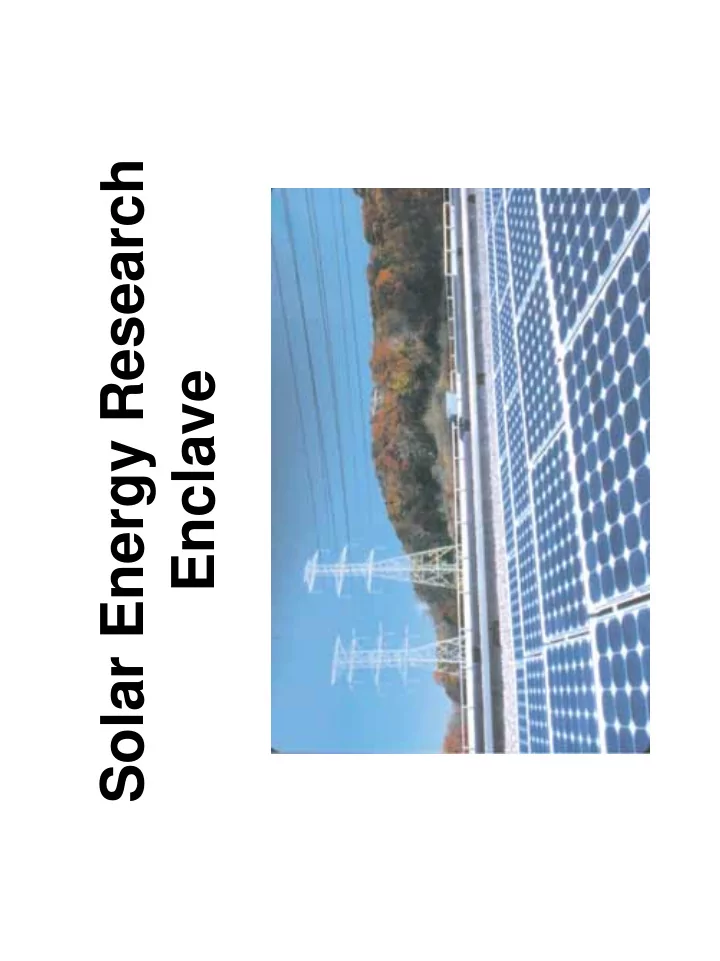

Solar Energy Research Enclave
Outline • Introduction • World Scenario • Indian Scenario • SWOT Analysis • Objectives • Technology Demonstrator • Summary
Energy Source & Utilization (US) SOURCE(%) USAGE � Hydro (1) � Wind (0.1) � Residential (11) � Solar (0) � Commercial (9) � Geo (0.3) � Industrial (24) � Nuclear(9) � Bio(3) � Transport (29) � Coal (23) � Natural gas(23) � Oil (40)
Trends towards World Energy Consumption Dr. RS Anand, EE Department, IIT 27 May 2009 Kanpur, INDIA 4
DAY NIGHT
Solar Energy Usage and Pricing Solar markets Solar (average of last 5 Price/Competing years) Energy source Remote Industrial 17% 0.1-0.5 times Remote Habitation 22% 0.2-0.8 times Grid Connected 59% 2-5 times Consumer Indoor 2% n/a Solar Energy: 30 c per kWh Need to lower cost to 10c per kWh and below http://www.solarbuzz.com/StatsCosts.htm
Japanese Road Map
Energy Source & Utilization (India) 2006 SOURCE (%) USAGE � Hydro(2) � Unaccounted � Wind(0) electricity(2) � Agriculture(6) � Solar(0) � Residential(28) � Geo(0) � Commercial(2) � Nuclear(1) � Industrial(29) � Bio(31) � Public utilities(.3) � Domestic Coal(30) � Transport(10) � Natural gas(6) � Imported petroleum(23)
Indian needs • Our country, therefore, requires solar energy development at different scales such as, – small (~W) to large (~MW) – grid-connected to islanded – supplemented with some energy-storage to no-storage capabilities. – hybridization of solar energy with other renewable sources
National Mission • On 30th June 2008 the Prime minister of India, Dr. Manmohan Singh, announced the National Plan for Climate Change. This includes a National Solar Mission to “significantly increase the share of solar energy in the total energy resources while recognizing the need to expand the scope of other renewable and non-fossil options such as nuclear energy, wind energy, and biomass”. • National Action Plan on Climate Change, Released on 30th June 2008 by Govt. of India
ITpower India (Blue Oak Energy)
ITpower India (Blue Oak Energy)
ITpower India (Blue Oak Energy)
•No national roadmap S W •World PV production •No Large size installation •Indian PV Export •Increasing Energy requirement •Will depend on US, Japan and Europe •Reduction of Fossil Fuels for efficient technology solutions •Energy dependence on imports O T
Objectives • 500 KW solar power station/research test-bed to be used as supplement to grid power to IITK during day time • Initiate research projects in the area of solar power generation, storage , and distribution to make this a viable solution for future energy requirements
Power Electronics Solar Power Sub-station “Technology Demonstrator” c - S i L P o V w Fuel Cells H c i g o h s t e & f f i c i e n c y
Outcomes • Overall cost of the energy technology decreases with large scale utilization • This has also encouraged the entrepreneurs to invest in solar energy technologies.
Contd. • Test platforms for large scale solar energy utilization technologies. • Increased awareness of green technologies amongst the public
Engaging faculty and students in long-term solar energy research and development Proposed Research Programs in three areas: Power Electronics Fuel Cells Photovoltaics Partha Sarathi Sensarma Raj Ganesh Pala (ChE) Raghubir S. Anand (EE) (EE) Shyama P. Das (EE) Malay K. Das (ME) Monica Katiyar (MME) Santanu K. Mishra (EE) Sameer Khandekar (ME) Y. N. Mohapatra (Phy) Kantesh Balani (MME) S. Sundar Kumar Iyer (EE) Krishanu Biswas (MME) Kallol Mandal (MME) Deepak Kunzru (ChE) Nitin Kaistha (ChE) Goutam Deo (ChE)
Specifics of Technology Demonstrator
Land required for solar energy capture • To install photovoltaic panels for 500kWp, an area of 10-12 acres (40000 -48000 m 2 ) is needed including service, maintenance, instrumentation, data collection, storage, panel preparation, control room, storage, research test-beds, and security.
Building 1D Concentrator 2D Concentrator Mono/Multi Silicon Thin Film Thermal -Anand
Budget & Time line • Ist phase (1-3 yrs): Estimated cost of a 500kWp solar sub-station and research initiation: Component Cost (Crores) Efficiency (%) PV- panels (Assuming a mix of 10 6 - 24 technologies to be used and average cost Rs.200/KW p ) Fuel Cells/Batteries 3 Power Electronics 2 Operational cost, maintenance 1 and security Research initiation for low-cost 2 Si material, high efficiency PV, fuel cells and power electronics Total 18 • IInd phase (4-6 yrs): Sustained funding of 4-5 crore per year will be needed for research projects to lower cost of solar energy.
Strengths of the core group • Raj Ganesh Pala (ChE) • Partha Sarathi Sensarma (EE) • Monica Katiyar (MME) • Malay K. Das (ME) – a-Si PV – Motorola, Inc • Raghubir S. Anand (EE) • Shyama P. Das (EE) • Santanu K. Mishra (EE) • S. Sundar Kumar Iyer (EE)
Summary If approved, a detailed project report will be submitted by the team.
FYI slide – not to be presented ITpower India (Blue Oak Energy)
Recommend
More recommend